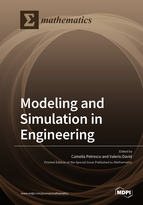Modeling and Simulation in Engineering
A special issue of Mathematics (ISSN 2227-7390). This special issue belongs to the section "Engineering Mathematics".
Deadline for manuscript submissions: closed (15 April 2022) | Viewed by 31949
Special Issue Editors
Interests: finite element analysis; modeling and simulation; electrical engineering
Special Issues, Collections and Topics in MDPI journals
Interests: measurements; survey of electric and magnetic fields; electromagnetic interference; biomedical measurements
Special Issues, Collections and Topics in MDPI journals
Special Issue Information
Dear Colleagues,
Advances in Information Technology and Computer Science in the last few decades have simplified the work of engineers in the design of new devices and systems, making modeling and simulation (M&S) a mandatory stage prior to the experimental setup. Thus, M&S has become part of the engineering culture.
This Special Issue is focused on presenting original research concerning mathematical models and simulation results based on advanced computer software.
The topics include, but are not limited to, the following:
- Modeling in mathematical physics;
- Behavioral analogies between different branches of physics;
- Simulation software;
- Numerical methods for partial differential equations;
- Optimization methods;
- Coupled problems;
- Modeling, simulation and optimization of electromagnetic devices;
- Simulation and optimization of electrical circuits;
- Decision support systems;
- Defining synthetic environments for engineering problems;
- Design of experiments;
- Models of measurement techniques;
- Computational processes in modeling and simulation.
Prof. Dr. Camelia Petrescu
Prof. Dr. Valeriu David
Guest Editors
Manuscript Submission Information
Manuscripts should be submitted online at www.mdpi.com by registering and logging in to this website. Once you are registered, click here to go to the submission form. Manuscripts can be submitted until the deadline. All submissions that pass pre-check are peer-reviewed. Accepted papers will be published continuously in the journal (as soon as accepted) and will be listed together on the special issue website. Research articles, review articles as well as short communications are invited. For planned papers, a title and short abstract (about 100 words) can be sent to the Editorial Office for announcement on this website.
Submitted manuscripts should not have been published previously, nor be under consideration for publication elsewhere (except conference proceedings papers). All manuscripts are thoroughly refereed through a single-blind peer-review process. A guide for authors and other relevant information for submission of manuscripts is available on the Instructions for Authors page. Mathematics is an international peer-reviewed open access semimonthly journal published by MDPI.
Please visit the Instructions for Authors page before submitting a manuscript. The Article Processing Charge (APC) for publication in this open access journal is 2600 CHF (Swiss Francs). Submitted papers should be well formatted and use good English. Authors may use MDPI's English editing service prior to publication or during author revisions.
Keywords
- simulation software
- numerical solutions of multi-physics problems
- advanced designing methods
- models and analysis of electromagnetic devices
- design of experiments and measurement techniques







